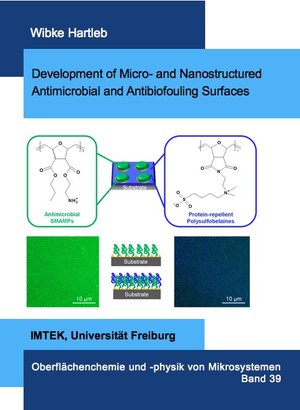
×
![Buchcover ISBN 9783843932882]()
Development of Micro- and Nanostructured Antimicrobial and Antibiofouling Surfaces
von Wibke HartlebThe adhesion of bacterial cells to surfaces of medical devices is a serious problem in healthcare. As soon as a complete biofilm is formed, neither antibiotics nor the immune system are able to intervene. Especially the formation of antibiotic-resistant biofilms on the surfaces of medical devices such as catheters or medical implants can cause life-threatening infections. For this reason, antimicrobial surfaces are promising candidates for biomedical applications. However, these antimicrobial surfaces alone are not able to prevent biofilm formation.
Four design strategies for coatings have been derived from the approaches that research has investigated to prevent biofilm formation: 1) Surface topography is unfavorable for the adhesion of bacteria if surface features are in the range or below the size of the bacterial cell (< 1 µm). Additionally, the topography has to be defect-free. 2) The adhesion of biomolecules, e. g. proteins, has to be prevented. 3) Microbes that manage to overcome the adhesion barrier need to be killed. 4) Dead microbes and debris must not remain on material surfaces.
To improve the performance of the available materials and strategies, a combination of diverse antibacterial and protein-repellent approaches is suggested. But literature lacks the investigation of simultaneous combination of chemical functionalization and surface structuring on bacterial cell adhesion.
The aim of this work was to generate micro- and nanostructured surfaces that could be modified with antimicrobial poly(oxonorbornene)-based Synthetic Mimics of Antimicrobial Peptides (SMAMPs) and protein-repellent poly(oxonorbornene)-based polysulfobetaine (PSB). Surface patterning with colloidal lithography and microcontact printing was combined with selective chemical functionalization using both antimicrobial and protein-repellent polymers. The antimicrobial part of these surfaces should kill bacterial pathogens upon contact, while the protein-repellent moieties should prevent protein and cell debris adhesion. To investigate the effect of the combined structured and polymer-modified surfaces, their antimicrobial and protein-repellent properties were investigated.
This new approach of combined structured and chemically modified surfaces described in this work offers the possibility to systematically investigate the most relevant influencing factor (topography and/or surface chemistry) on the prevention of bacterial adhesion and biofilm formation.
Four design strategies for coatings have been derived from the approaches that research has investigated to prevent biofilm formation: 1) Surface topography is unfavorable for the adhesion of bacteria if surface features are in the range or below the size of the bacterial cell (< 1 µm). Additionally, the topography has to be defect-free. 2) The adhesion of biomolecules, e. g. proteins, has to be prevented. 3) Microbes that manage to overcome the adhesion barrier need to be killed. 4) Dead microbes and debris must not remain on material surfaces.
To improve the performance of the available materials and strategies, a combination of diverse antibacterial and protein-repellent approaches is suggested. But literature lacks the investigation of simultaneous combination of chemical functionalization and surface structuring on bacterial cell adhesion.
The aim of this work was to generate micro- and nanostructured surfaces that could be modified with antimicrobial poly(oxonorbornene)-based Synthetic Mimics of Antimicrobial Peptides (SMAMPs) and protein-repellent poly(oxonorbornene)-based polysulfobetaine (PSB). Surface patterning with colloidal lithography and microcontact printing was combined with selective chemical functionalization using both antimicrobial and protein-repellent polymers. The antimicrobial part of these surfaces should kill bacterial pathogens upon contact, while the protein-repellent moieties should prevent protein and cell debris adhesion. To investigate the effect of the combined structured and polymer-modified surfaces, their antimicrobial and protein-repellent properties were investigated.
This new approach of combined structured and chemically modified surfaces described in this work offers the possibility to systematically investigate the most relevant influencing factor (topography and/or surface chemistry) on the prevention of bacterial adhesion and biofilm formation.


